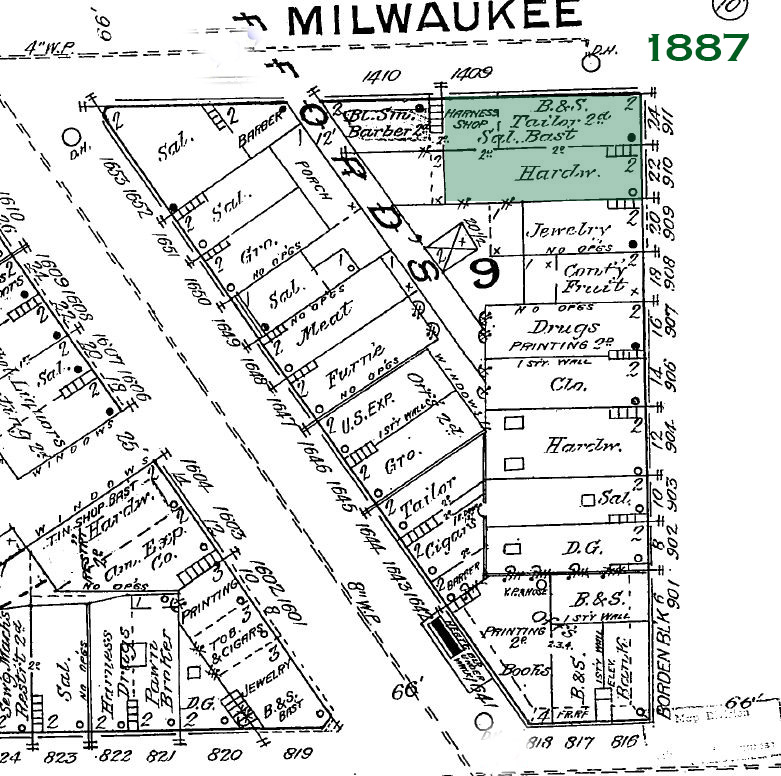22-24 DOUGLAS AVENUE
HISTORIC SIGNIFICANCE
22-24 Douglas Avenue is considered one of the earliest commercial buildings located within the Elgin Downtown Commercial Historic District built around the late-1860s. The property was first owned by Alfred Hadlock who sold the property to Ferdinand Weber in 1868 for $8,000.
Ferdinand Weber was born September 13, 1811 in Liekwegen, Kreis Schaumburg. He emigrated from Bremen aboard the ship Monterey and arrived in New York on September 27, 1848 along with his wife, Engel, nee Pfingsten, and their four young daughters.
The Weber family made their way to Hanover Township where Ferdinand quickly bought a farm. Now with seven daughters, Ferdinand turned to other opportunities to support and provide for his family. He turned to the growing city of Elgin and decided to purchase a parcel of property.
At that time (1868), Mr. Weber co-signed the mortgage with his son-in-law, Frederich Stolt with the agreement that when Mr. Stolt paid the mortgage in full, that Mr. Weber would transfer half the property (north half, 22 Douglas Avenue) to him. In 1878, Mr. Weber sold the south portion of the property (24 Douglas) for $7,000 to his other son-in-law, Christoph Tatge.
Unfortunately, Mr. Stolt died in 1882 before the debt was paid. His widow, Augusta Weber Stolt was forced to sell his half of the property (22 Douglas Avenue) in November of 1882 in order to meet the debts from the estate including the claim made by her father, Ferdinand Weber. In December of 1882, Augusta Weber Stolt, now Wahl, was able to purchase the property back for $8,922.75. At that time, the north portion of the property included a harness shop located off of Highland (formerly known as Milwaukee) Avenue, along with a Boots and Shoes store on the first floor, a Tailor on the second floor, and a saloon in the basement. These businesses remained there until 1897 when the first floor became a restaurant and the harness store became a tobacco and barber shop. The south portion of the building held a hardware store all of which remained there until 1897 when the hardware store became a saloon.
That same year, Ferdinand Weber passed away in Bartlett, Illinois on December 22, 1882 and was buried at Bluff City Cemetery.
By 1895, Augusta and her second husband, William, sold the north portion of the building to her brother-in-law, Christoph for $17,000. He owned the building in totality until 1905 when he sold the north part of the property to his son-in-law, Gottlieb Schick, for $13,000, who was married to his daughter, Ida.
In 1910, Gottlieb sold the north part of the property to his brother, August Schick who held onto the property until 1917 when it was sold to David and Tillie Goldforb. In 1916, 24 Douglas Avenue was sold to Morris Rosengarten. At that time, the businesses within 22 Douglas Avenue included a saloon on the first floor and a cigar factory on the second floor and 24 Douglas Avenue still had a saloon. Around 1945, 22 Douglas Avenue was occupied by ‘Messerschmidt’s,’ a general store that sold dresses, lingerie, hosiery, curtains, gifts and housewares whereas 24 Douglas was occupied by ‘Peoples Liquor Store.’
ARCHITECTURAL SIGNIFICANCE
22-24 Douglas Avenue is an excellent example of a two-part commercial block building in the Italianate style. The building’s envelope consists of cream colored brick, with original, arched four-over-four lite, single hung windows with limestone keystones at its second floor. Uniquely, the south portion of the building has one-over-one lite, single hung windows, likely a way to differentiate that the building historically had dual ownership. The original, projecting wood cornice has two heavy brackets that flank each end of the cornice with evenly spaced dentils between the brackets. In addition, a pediment with a sunburst design is centrally placed on the cornice. At the street level, the two store fronts have been rehabilitated with a central access door that leads up to the second floor. The cast iron column and the brick pier that are found on either side of the central entry to the second floor are the only original elements that remain from the historic storefront.
Sources: Research: John Weiss; Historic Image; Audio: TextAloud












